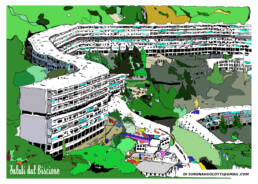The Genoese consider the Biscione a controversial architecture for its aesthetics and history. It was built like a huge snake to give home to the poor after the war and to the evicted from wretched demolition.
The council houses have similar stories, they are recognizable in the cliché of a suburb next to the industry, or sometimes identifiable in constructions climbed on raped hills.
There were many architects who, however, thought of praiseworthy projects, imagined small autonomous “city-countries” between theatres, churches, shops and sports facilities. However, all this did not work when it was the heroine who became the queen symbol of degradation.
Today the suburbs live again in the playgrounds and not on rubbish courts, theatres are popular again and communities have been built by regenerating their origins. Many industries have closed their doors, trees are growing and re-appropriating many spaces, rivers are repopulating. The unattainable hill today is a place of liveable peace, surrounded by greenery and close to the metropolis, in this case Genoa. New ecological projects are taking off: “from degradation are born the flowers”.
Simona Ugolotti
I lived 30 years as a farmer in the Apennines, singing with the name of “Cantadina”. Then I came back to Genoa, transforming rural life into vocal and graphic art.

